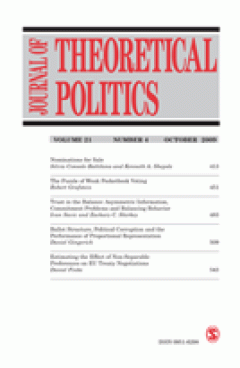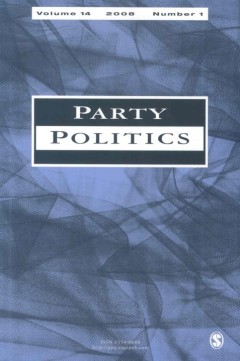Filter by

Ambiguous Statutes and Judicial Deference To Federal Agencies
The Supreme Court’s Chevron decision raises questions about why Congress passes ambiguous statutes and why courts defer to agencies rather than impose their own interpretations. This article presents a model of policymaking where the legislature chooses strategically between an ambiguous and explicit statute, and where rulemaking and judicial review follow. The analysis reveals that when statut…
- Edition
- Vol. 22, No. 2, April 2010. pp 217-245
- ISBN/ISSN
- 09516298
- Collation
- -
- Series Title
- Journal of Theoretical Politics
- Call Number
- -

The Implications of High Court Docket Control for Resource Allocation and Leg…
A key source of institutional variation across judicial systems is the degree of control that the highest court has over its docket. Despite this variation, the consequences of various institutional designs in judicial hierarchies remain relatively unexplored by the theoretical literature. In this article, we develop a formal model of high court resource allocation. We analyze the model under t…
- Edition
- Vol. 22, No. 2, April 2010. pp. 247-268
- ISBN/ISSN
- 09516298
- Collation
- -
- Series Title
- Journal of Theoretical Politics
- Call Number
- -

Coups, Elections and the Predatory State
Even in the absence of elections, incumbents face threats to their survival which could induce them to reduce self-interested rent-seeking behavior. I compare the differences in incentives for incumbents to reduce rent extraction when they face a threat of being overthrown as opposed to when they face competitive elections. The key difference between the situations is that while voters do not g…
- Edition
- Vol. 22, No. 2, April 2010. pp. 169-215
- ISBN/ISSN
- 09516298
- Collation
- -
- Series Title
- Journal of Theoretical Politics
- Call Number
- -

Political Accountability Under Alternative Institutional Regimes
We analyze the interaction between electoral accountability and separation-of-powers by comparing three regimes: ‘Unilateral Authority’ (the President has exclusive decision-making power); ‘Mandatory Checks’ (the President cannot change policy without congressional assent); and ‘Opt-in Checks’ (the President may seek congressional authorization or act unilaterally). We find: (1) voters use asym…
- Edition
- Vol. 22, No. 2, April 2010. pp 139-167
- ISBN/ISSN
- 09516298
- Collation
- -
- Series Title
- Journal of Theoretical Politics
- Call Number
- -

Does ‘Civic Duty’ ‘Solve’ The Rational Choice Voter Turnout Puzzle?
Rational choice models of voter turnout try to account for why people vote by including on the ‘benefits’ side of the cost-benefit calculus some term representing either the collective benefits of voting or the satisfaction the individual derives from the very act of voting, a strategy subject to a number of telling criticisms. After a background discussion of three competing perspectives on th…
- Edition
- Vol. 22 no. 3 July 2010 pp. 275-300
- ISBN/ISSN
- 09516298
- Collation
- -
- Series Title
- Journal of Theoretical Politics
- Call Number
- -

Proportional Representation and Strategic Voters
The goal of this paper is to examine the incentives to vote insincerely, other than those created by rounding, faced by voters in systems of proportional representation (PR). We rigorously investigate two models of voter behaviour. The first model assumes that a voter is primarily interested in the distribution of seats in the post-election parliament (seat maximizer) while the second considers…
- Edition
- Vol. 22 no. 3 July 2010. pp. 301-332
- ISBN/ISSN
- 09516298
- Collation
- -
- Series Title
- Journal of Theoretical Politics
- Call Number
- -

Electoral Competition When Some Candidates Lie and Others Pander
In this paper we analyze a two-candidate electoral competition in which a candidate can either lie about his private policy preference in order to get elected, or pander to post-election external influences in choosing a policy to implement. Both the pre-election announcement and post-election implementation are a candidate’s strategic choices. We show that, in equilibrium, different types of c…
- Edition
- Vol. 22 no. 3 July 2010.pp. 333-358
- ISBN/ISSN
- 09516298
- Collation
- -
- Series Title
- Journal of Theoretical Politics
- Call Number
- -

Power Sharing and Reform Capacity
In this paper I argue that reform capacity, defined as the extent to which political institutions facilitate the adoption of socially efficient reforms, is not primarily determined by the number of veto players in the political system, but by the availability of institutional mechanisms that allow political agents to solve commitment problems associated with bargaining over reform. Specifically…
- Edition
- Vol. 22 no. 3 July 2010.pp. 359-376
- ISBN/ISSN
- 09516298
- Collation
- -
- Series Title
- Journal of Theoretical Politics
- Call Number
- -

Evaluating the Unfairness of Representation With the Nash Social Welfare Func…
Using the Nash product (Nash Social Welfare Function) as a micro foundation, we create a decomposable index to evaluate the unfairness of representation in electoral districts. Using this index, we decompose the factors of such unfairness into apportionment and districting. We explore the situations of New Zealand, the United States, Australia, the United Kingdom, Japan, and Canada. We then pro…
- Edition
- Vol. 22 no. 4, October 2010.pp. 445-467
- ISBN/ISSN
- 09516298
- Collation
- -
- Series Title
- Journal of Theoretical Politics
- Call Number
- -

Transparency and Accountability: Empirical Results for Us States
Recent formal models of accountability allow us to make different conditional predictions about how transparency affects voters’ willingness to re-elect incumbents and acceptance of higher taxes. We review two models and investigate empirical implications derived from or related to them, using panel data from 1972—2000 for U.S. state budget process transparency, gubernatorial elections, and tax…
- Edition
- Vol. 22 no. 4, October 2010,pp. 379-406
- ISBN/ISSN
- 09516298
- Collation
- -
- Series Title
- Journal of Theoretical Politics
- Call Number
- -

Ideology and Existence of 50%-Majority Equilibria in Multidimensional Spatial…
When aggregating individual preferences through the majority rule in an n-dimensional spatial voting model, the ‘worst-case’ scenario is a social choice configuration where no political equilibrium exists unless a super-majority rate as high as 1 — 1/(n+1) is adopted. In this paper we assume that a lower d-dimensional (d < n) linear map spans the possible candidates’ platforms. These d ‘ideolog…
- Edition
- Vol. 22 no. 4, October 2010.pp. 431-444
- ISBN/ISSN
- 09516298
- Collation
- -
- Series Title
- Journal of Theoretical Politics
- Call Number
- -

Power Concentration and Interstate Conflict: Is There a Connection?
Singer et al. (1972) hypothesized that the distribution of military—industrial capabilities among the major powers, as reflected in an index referred to as CON, would have an impact on the incidence of war for those states. Subsequent research on the possible connection between CON and interstate conflict has continued for almost four decades. A recent book declares that CON is the single most …
- Edition
- Vol. 22 no. 4, October 2010,pp. 407-429
- ISBN/ISSN
- 09516298
- Collation
- -
- Series Title
- Journal of Theoretical Politics
- Call Number
- -

The Inevitable Two-State Solution
By 2033, two states, Israel and Palestine, will be living side-by-side in an uneasy peace, with the risk of war between them and terrorism across their common border diminishing year by year. This two-state solution will not be imposed by the United States or the Arab world. It will be freely chosen by the Israelis and Palestinians themselves. The growing Palestinian majority living between the…
- Edition
- Vol. 25, No. 3, Fall 2008. Page 59–67
- ISBN/ISSN
- 0740-2775
- Collation
- -
- Series Title
- World Policy Journal
- Call Number
- -

Dominant party systems and electoral volatility in Africa: a comment on mozaf…
In a recent publication in this journal, Mozaffar and Scarritt claim to have found a puzzling combination of low fragmentation and high volatility in African party systems. However, if we look at national party systems rather than Africa-wide averages, include regime type as a variable and specify dominance, we find three different constellations: dominant party systems with relatively low …
- Edition
- Vol. 14, No. 1, January 2008. Page 113-130
- ISBN/ISSN
- 13540688
- Collation
- -
- Series Title
- Party Politics
- Call Number
- -

Intra-party politics and coalition formation: evidence from Swedish local gov…
Traditional theories about government formation in parliamentary democracies are based on the assumption that parties can be characterized as unitary actors. Many authors have questioned the soundness of this assumption. The problem with keeping it is that we may miss important factors explaining why certain coalitions form if we do not consider the role of intra-party politics. In this a…
- Edition
- Vol. 14, No. 1, January 2008. Page 71-89
- ISBN/ISSN
- 13540688
- Collation
- -
- Series Title
- Party Politics
- Call Number
- -

Equal access, unequal success major and minor Canadian parties on the net
The Internet has been heralded as the most revolutionary technology since the printing press. Within political science, much work centres around the democratizing potential of the Internet. Cyber-optimists argue that the Internet has the capacity to equalize political competition for parties. Other scholars argue that the Internet will not dramatically change the status of minor parties. …
- Edition
- Vol. 14, No. 1, January 2008. Page 51-70
- ISBN/ISSN
- 1354-0688
- Collation
- -
- Series Title
- Party Politics
- Call Number
- -

Rational Expectations or Heuristics?: Strategic Voting in Proportional Repres…
The process of information of electoral expectations in proportional representation systems is analysed in this article. Contrary to Duvergerian or electoral coordination theories, by using survey and in-depth elite intervieew data from Spain in the 1970s and 1980s, it is show that strategic voting depends on heuritics rather than on rational expectations. The main implication is taht strategic…
- Edition
- Vol. 14, No. 1, January 2008. Page 31-49
- ISBN/ISSN
- 1354-0688
- Collation
- -
- Series Title
- Party Politics
- Call Number
- -

The Politics of Institutional Change: Electoral Reform in Latin America, 1978…
Building on the growing body of research on political institutions, this article explores the causes of electoral reform, with specific reference to Latin America. What factors account for the extensive array of electoral reforms adopted in the region since the return to democracy? How are shifting patterns of political representation related to institutional change? In addressing these q…
- Edition
- Vol. 14, No. 1, January 2008. Page 5-30
- ISBN/ISSN
- 1354-0688
- Collation
- -
- Series Title
- Party Politics
- Call Number
- -

Fluid party systems, electoral rules and accountability of legislators in eme…
Does the system of repeated parliamentary elections function as a mechanism of political control in new democracies with fluid party systems? Moreover, does electoral format affect the degree to which voters are able to hold legislators accountable for their performance in office? In addressing these questions, we use a new database on all legislative incumbents and all parliamentary elections …
- Edition
- Vol. 14, No. 1, January 2008. Page 91-112
- ISBN/ISSN
- 13540688
- Collation
- -
- Series Title
- Party Politics
- Call Number
- -

Online Electoral Competition in Different Settings: A Comparative Meta-Analys…
This article takes a close look at two important theories concerning the effects that online party campaigning has on party competition. The equalization and normalization theories are tested for systematic logical dependence on conditions present in existing studies within the research field. The conditions are country-specific contextual settings and studyspecific methodology. The method of q…
- Edition
- Vol. 14, No. 2, March 2008. Page 223-244
- ISBN/ISSN
- 13540688
- Collation
- -
- Series Title
- Party Politics
- Call Number
- -
 Computer Science, Information & General Works
Computer Science, Information & General Works  Philosophy & Psychology
Philosophy & Psychology  Religion
Religion  Social Sciences
Social Sciences  Language
Language  Pure Science
Pure Science  Applied Sciences
Applied Sciences  Art & Recreation
Art & Recreation  Literature
Literature  History & Geography
History & Geography